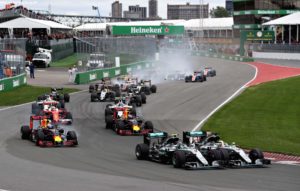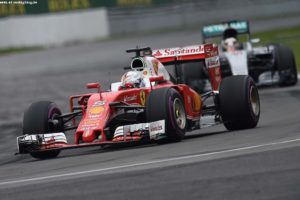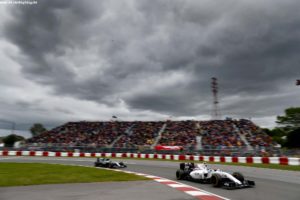Ferrari has had chances to win Grands Prix this year, but has not been able to take them. In Australia the race got away from them due to strategy and in Canada they made a big strategy call early in the race, which handed track position advantage to Lewis Hamilton and Mercedes. But did this call cost Sebastian Vettel a win, as in Melbourne? Or did they do the right thing to try it, even though the result went Hamilton’s way?
 We will analyse this and some of the other notable results, like Valtteri Bottas’ first podium of the season and Carlos Sainz’s recovery to the points from the back of the grid. After seven races it is already clear that the races are more enjoyable this year, due to the wider choice of tyres and that strategy is more important to the outcome than ever. Canada has always been touch and go whether to choose a one stop or a two-stop strategy. One-stop gives you track position, but two stops is faster.
We will analyse this and some of the other notable results, like Valtteri Bottas’ first podium of the season and Carlos Sainz’s recovery to the points from the back of the grid. After seven races it is already clear that the races are more enjoyable this year, due to the wider choice of tyres and that strategy is more important to the outcome than ever. Canada has always been touch and go whether to choose a one stop or a two-stop strategy. One-stop gives you track position, but two stops is faster.
A two stop is invariably preferable if you can run in clear air, but on the tyres available this year, Ultra soft, Super Soft and Soft there were not many in the paddock that felt that a one stop was feasible. Force India, for example, a team that can normally get results from doing a stop fewer than its rivals, was not able to attempt a one stop strategy this year in Montreal.
The Ultra soft was the fastest qualifying tyre, so that was the starting tyre for the Top Ten, but the Super soft didn’t perform well in the Friday practice sessions, so few teams had any desire to use it in the race. Apart from the two cars that started on it and Perez, who had a nightmare with it, only Ferrari decided to use it for a stint in the race. It’s never good to be the outliers in a situation like that.
Ferrari did little practice running and data gathering on the soft tyre, which turned out to be the best tyre for the race. It had less graining and degradation than the others and because it was longer lasting it gave better flexibility to the strategy.
Ferrari did use it for five laps in Saturday’s FP3 session, which meant that they did not have two new sets of softs available for the race if they were going for a two-stop plan. This was their first mistake.
Did Ferrari cost Vettel the win with the early strategy call to pit?
 Having taken the lead from the Mercedes at the start, Vettel was in a strong position in the first stint of the race. He was able to hold Hamilton outside DRS range, in other words more than a second behind. And the bonus was that with Max Verstappen falling back and Nico Rosberg having gone off track in a close call with Hamilton at Turn 1, the second Mercedes was down in 9th place. So there was no threat from behind to the lead battle. Vettel and Hamilton were going to finish 1-2; the only question was which one would win?
Having taken the lead from the Mercedes at the start, Vettel was in a strong position in the first stint of the race. He was able to hold Hamilton outside DRS range, in other words more than a second behind. And the bonus was that with Max Verstappen falling back and Nico Rosberg having gone off track in a close call with Hamilton at Turn 1, the second Mercedes was down in 9th place. So there was no threat from behind to the lead battle. Vettel and Hamilton were going to finish 1-2; the only question was which one would win?
Ferrari planned a two-stop strategy before the race. Hamilton said that Mercedes did too, but the reality was more subtle. Mercedes were more open minded about which way to go and they planned to take their clues from the early laps, tyre warm up and general performance of the soft and Ultra Soft tyres then decide.
The turning point moment was the retirement of Jenson Button’s McLaren on Lap 11. It was an engine failure, so there was no debris to clear. Therefore it was clear that this was likely to be a short-lived Virtual Safety Car period, when it was activated.
Ferrari were in a two stop mindset and they saw an opportunity with the VSC to take a stop and save some race time, as the saving is around 6 seconds compared to racing speeds. They didn’t get all of this saving because the VSC ended while Vettel was in the pit lane.
By stopping at least 8 laps before the optimum stop lap for a two stop strategy, they lost the track position to Hamilton, but also lost the levers to control the race. Stopping early meant that Vettel had to deal with traffic, whereas he would have had a gap to drop into if they had waited another 8-10 laps.
But the biggest problem was that they fitted the Super Soft tyre, which wasn’t performing that weekend. The ideal would have been to fit new softs, which would also have given more range and flexibility.
So what was the thinking? It’s clear that the thinking was rushed in the moment of the VSC. Certainly bringing Raikkonen in was a mistake, as the VSC had ended by then so he gained none of the time benefit and ended up in traffic on SuperSoft tyres, which was a double whammy for him. It was surprising that Ferrari didn’t hedge their best by splitting the strategies, but Raikkonen was slower than Vettel all weekend.
 Ferrari clearly felt that the Mercedes was a faster car and that they needed to do something different and more aggressive, to beat Hamilton on the day. If they had stayed out, Hamilton would have likely undercut them at the second stop because the Mercedes can run longer in the final stint, so Mercedes would have pitted early for the second stop and won the race that way. Ferrari wanted to try to set a different agenda and you can understand that.
Ferrari clearly felt that the Mercedes was a faster car and that they needed to do something different and more aggressive, to beat Hamilton on the day. If they had stayed out, Hamilton would have likely undercut them at the second stop because the Mercedes can run longer in the final stint, so Mercedes would have pitted early for the second stop and won the race that way. Ferrari wanted to try to set a different agenda and you can understand that.
By stopping early, they knew that this would push Mercedes’ strategist into switching Hamilton onto a one stop strategy, without knowing for sure what state the tyres would be in at the end.
Pirelli had briefed that it was possible to do 50 laps on a set of softs, but wear life should not be confused with performance life. Pirelli’s note merely said that the tyre would not wear out for 50 laps, which did not mean that the performance wouldn’t drop off a cliff before then. The art of this game is in the tyre model you build through practice sessions and in how you adapt it to the varying conditions and temperatures.
The first indication Mercedes had that it was definitely going to work was when Rosberg was forced to pit on Lap 51 for a puncture. This allowed them to examine his soft tyres, which were 30 laps old and extrapolate the performance life. They knew then that Hamilton would be able to hold on and win the race.
Did Ferrari make mistakes? Yes, they handicapped themselves by not being able to run two new sets of soft tyres in the race and there are other things they could have tried that might have been more effective than pitting under the VSC.
Did it cost Vettel the win? The consensus is probably not as Mercedes had a slightly faster car and better tyre life, so the Mercedes strategist would always have had undercut opportunities and other levers he could pull to win the race.
Williams take a big risk to get Bottas his first podium of the season.
 Williams has traditionally gone well in Montreal and although they again qualified poorly behind Red Bull, they beat them to the podium with a very bold strategy. Effectively Bottas did the same strategy as Hamilton, stopping one lap earlier and thereby getting track position advantage over the two Red Bull cars. He also took advantage of the mistakes made on Raikkonen’s strategy.
Williams has traditionally gone well in Montreal and although they again qualified poorly behind Red Bull, they beat them to the podium with a very bold strategy. Effectively Bottas did the same strategy as Hamilton, stopping one lap earlier and thereby getting track position advantage over the two Red Bull cars. He also took advantage of the mistakes made on Raikkonen’s strategy.
Williams have been criticised in the past for not being bold enough, but they took a chance on the soft tyres holding out and it paid off.
A great deal of credit needs to be given to Bottas and Hamilton for not locking up and damaging the tyres, as other drivers did. When you make a bold call to do the 70 lap race with just two sets of tyres, it’s essential that the driver maintains strong pace while not damaging the tyres and the Ultra and SuperSofts were both very fragile to lock ups and graining. If that happened, performance went out of the window.
Sainz and Toro Rosso pull off a great recovery
Carlos Sainz had looked competitive in practice but made a costly mistake in qualifying which damaged the car and put him 20th on the grid. From here he managed to come through and finish in 9th place.
Ironically this came about due to an aggressive two-stop plan, whereby Sainz was pitted two laps after the VSC. Toro Rosso could see that it was ending so did not follow Ferrari down the pit lane, instead they left it two more laps and brought him in for Soft tyres, which gave them flexibility in the second stint length.
Their next play was a chess move; they made moves in the pit lane and brought in Danill Kvyat from 13th place aggressively early in Lap 17. The idea was to get Haas and McLaren to react and pit Grosjean and Alonso, which they did. This opened up the space for Sainz, whose tyres were now in perfect condition. So this took him up to 11th place. It was a classic Toro Rosso/Red Bull move, using one driver to the benefit of the other and it worked for a good team result.
Sergio Perez had started on softs and took the supersofts at his stop on Lap 30, but they did not perform. So this gave Sainz the chance to take another position. Massa’s retirement gave him another.

